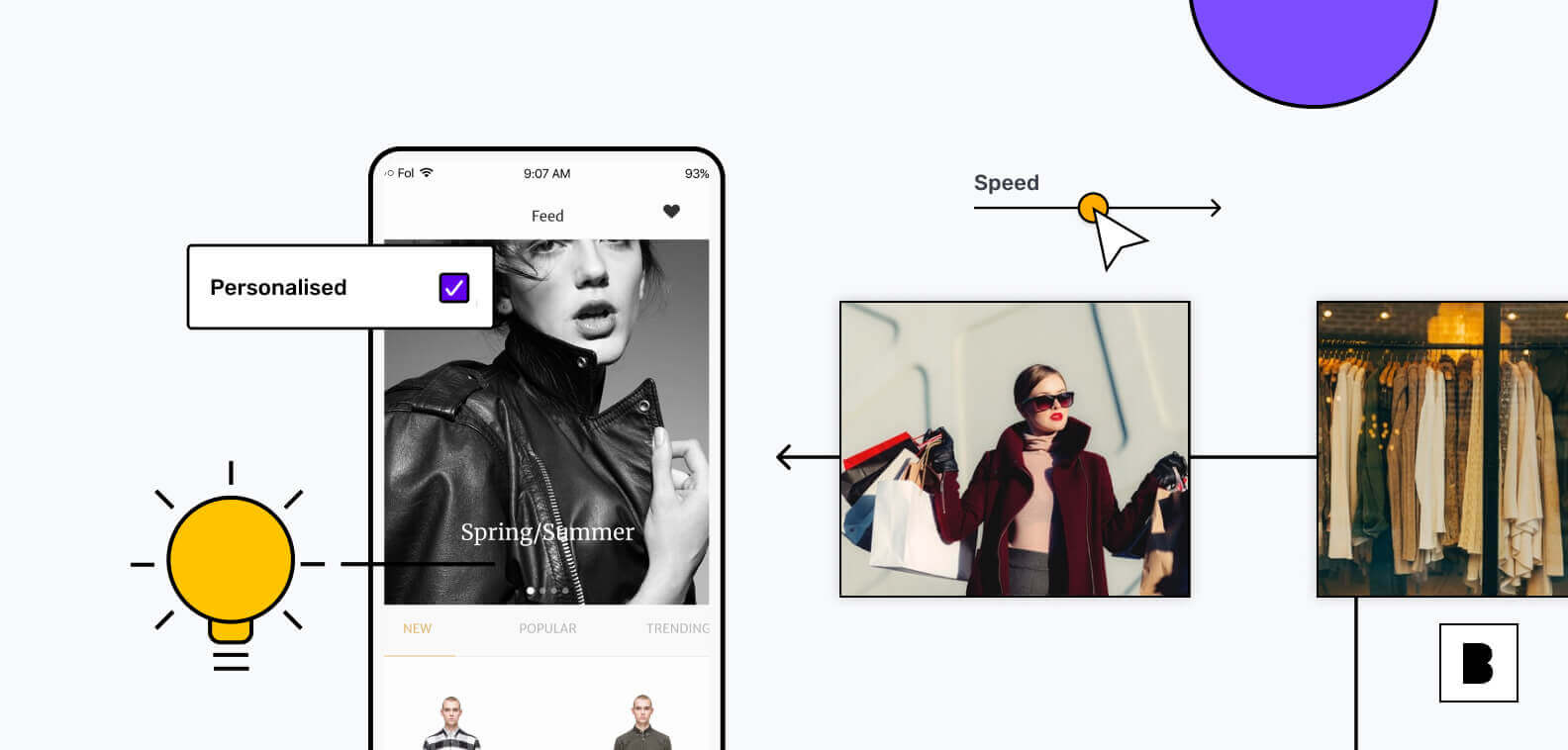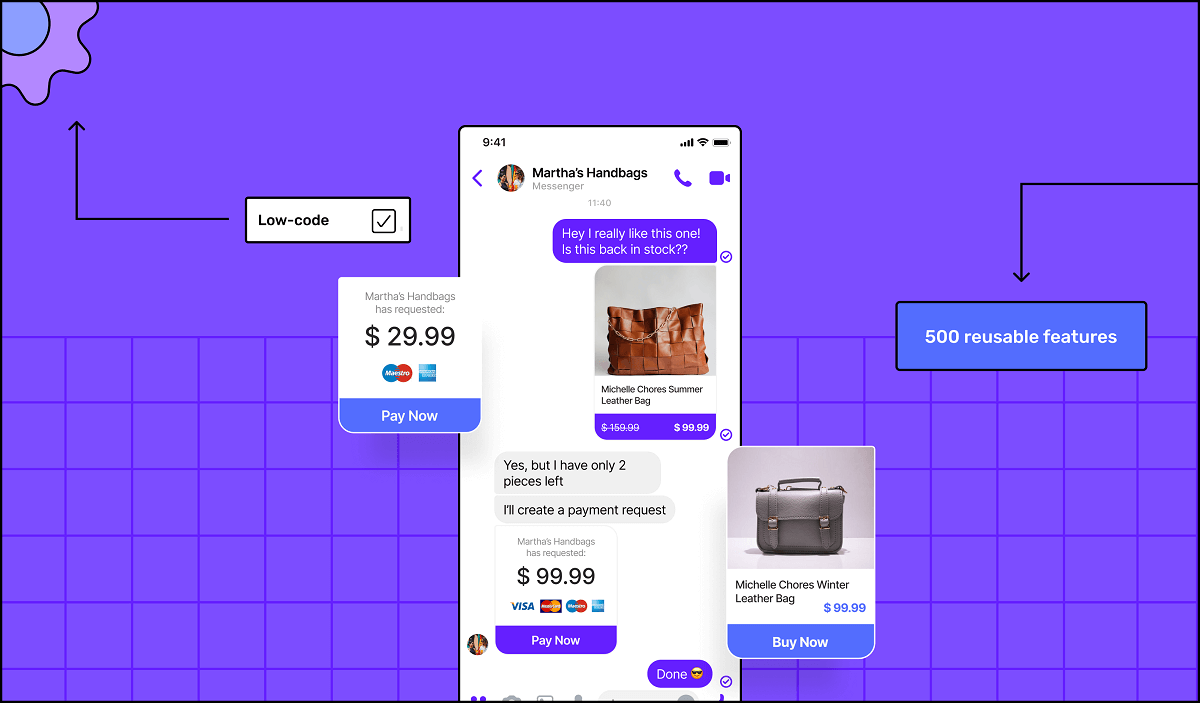In a world where ecommerce trends come and go faster than a package delivered by Amazon Prime, it can be tempting to jump on every new fad that comes along.
But before you do, you need to take a step back and ask:
Does this support my business goals? And is it something my customers actually need?
If the answers to these questions aren’t a resounding yes, implementing them might actually be more of a hassle than they’re worth.
Saying this, there are still a bunch of traps it’s easy enough to fall into, if you’re not careful.
That’s why we’ve put together a comprehensive list of mistakes you need to avoid, while recommending the approaches that are sure winners for your business.
So, get comfortable, grab a snack, and let’s go 👇
21 ecommerce trends consumer behaviour suggests you should avoid
- Not following an omnichannel branding strategy
- Using basic (and unscalable) ecommerce website templates
- Not tracking ecommerce data
- Neglecting optimisation for mobile commerce
- Failing to provide potential customers with personalised experiences
- Spray-and-pray email blasts
- Failing to prioritise customer service and support
- Ignoring customer loyalty programs
- Relying completely on traditional marketing
- Failing to provide fast delivery and flexible returns
- Prioritising discounts and promotions over value
- Not paying attention to environmental sustainability
- Relying solely on paid marketing
- Ignoring customer reviews
- Forgetting about prioritising data privacy and security
- Ignoring voice search
- Sidestepping social media influencers
- Overreliance on a single product category or niche
- Ignoring Augmented and Virtual reality (AR/VR)
- Disregarding the importance of user-generated content and community building
- Creating non-inclusive brands
- Conclusion
1 - Not following an omnichannel branding strategy
Omnichannel is the key to making online shopping a seamless, unified buying across all channels. And not paying attention to it has serious consequences:
According to the Harvard Business Review, companies with bad omnichannel strategies only keep 33% of their buyers. Adding insult to injury, customers also have less trust in your brand.
Whereas, companies with an omnichannel strategy in place build trust, keeping 89% of their customers.
That results in a 30% higher customer lifetime value (CLV), while omnichannel customers also spend more in-store and online.
The importance of keeping your branding and messaging consistent across all channels, then, is plain to see.
To achieve this for your online store, think about:
- Implementing a responsive website that can adapt to different screen sizes and devices
- Creating an app that's seamless and easy to navigate
- Ensuring you have consistent branding and messaging across your website, app, socials and brick-and-mortar stores
2 - Using basic (and unscalable) ecommerce website templates
Could you watch The Lord of the Rings trilogy in the time it takes your site to load?
Is your checkout process as smooth as a dirt track?
Are you unable to add new features that could wow potential customers?
These are clear signs that you’ve outgrown your current ecommerce site. Which, if left to its own devices, could kill your dream to scale your business stone dead.
Instead, you need a site that’s accessible, user friendly and responsive on mobile devices. And more importantly, you need one that can grow alongside you.
Here are the benefits any ecommerce website builder worth its salt should deliver:
- Scalability- you can customise your website to meet emerging customers needs
- Capacity - you can host on the cloud, allowing you to cope with increasing traffic demands, while maintaining site speed
- Automations- you can automate key ecommerce processes through your site, allowing your business to become leaner and more efficient
- Integrations - you can connect your site with other platforms you use, streamlining the hand-off process
- Aftercare - you’re supported after your website project is complete
3 - Not tracking ecommerce data
The key to understanding customer behaviour and making informed decisions? Data, of course.
By tracking Key Performance Indicators (KPIs) like…
- Traffic
- Conversion rates
- Average Order Value (AOV)
- Customer Lifetime Value (CLV)
…you can optimise your sales funnel and iterate on successful strategies to generate even more sales.
Take the well-known outdoor gear company The North Face as an example. They increased their conversions by a staggering 60% by A/B testing different versions of their product pages.
Custom diamond jewellery manufacturer, Brian Gravin Diamond, also increased their online revenue, using Google Analytics (GA). They did that by watching user behaviour and pinpointing areas for improvement.
After leveraging GA’s Advanced Ecommerce function, the company decided to create a guest checkout flow which helped recover $500K in abandoned carts.
Without this data, both companies would’ve missed out on an eye watering number of sales, seriously harming their business.

Studio Store’s real-time ecommerce dashboard also helps protect against this, monitoring daily, monthly, quarterly and annual sales KPIs.
This means you can benchmark your current performance against historical data and make accurate financial forecasts.
Want to build your online store?
Book a demoSpeak with one of our product experts today.
By proceeding you agree to Builder.ai’s privacy policy and terms and conditions

4 - Neglecting optimisation for mobile commerce
Let’s think about Etsy:
More than 75% of their website visits in 2020 came from mobile devices. If you think this happened by accident, you’re dead wrong. The company’s success was a result of a heavy investment, which skyrocketed their sales by 110%.
To achieve results like these, you need to do more than just make your desktop site accessible for Android and iOS mobile users…
You should also think about investing in an ecommerce app. With one, you can:
- Leverage push notifications to increase customer engagement and improve conversion rates
- Use customer data to deliver personalised experiences and tailored offers
- Provide an array of payment options to discourage cart abandonment
- Solve customer queries quicker with in-app comms
- Allow users to browse and save your products offline
Progressive Web Apps (PWAs), meanwhile, deliver many of these benefits but are discoverable only on search engines, rather than mobile app stores.
5 - Failing to provide potential customers with personalised experience
Personalisation is hot on the agenda for every ecommerce company. Now enabled by big data and artificial intelligence, brands can offer tailored experiences, making customers more likely to buy.
For instance, Amazon personalises product recommendations for each consumer. It uses sophisticated algorithms to track the shopping habits, browsing habits, and other data points of their buyers. As a result, it retains more customers and maximises its revenue.
But you don’t have to be a tech giant to do the same for your customers. All you need to do is own the customer relationship end to end.
This is possible with your own online selling platform, which allows you to capture customer data and create personalised experiences for buyers. How?
By analysing their behaviour, preferences and interests. As a result, you can provide them with customised content, product recommendations and targeted marketing campaigns.
When you sell on marketplaces alone, you do provide this to customers. But the key difference is these platforms get all the customer data, allowing them to build loyalty to their platform, rather than your store.
6 - Spray-and-pray email blasts
It's time to face the music:
The days of blasting generic, one-size-fits-all emails to your entire subscriber list are over. At least if you’re expecting positive results.
That’s because messages that aren’t tailored to specific audiences get dropped in the trash. But fear not, because the solution is simpler than you might think:
Leveraging data and technology, ecommerce businesses can stay ahead of the curve.Think of the steps listed below as a guide to create hyper-targeted email strategies.
- Collect customer data from website analytics, email marketing, and social media
- Analyse the data to understand customer demographics, behaviour, preferences, and purchase history
- Segment your email listinto different groups based on the analysed data
- Create targeted email campaigns that resonate with each group's unique needs and interests
- Personalise the email content with relevant product recommendations, promotions, and awareness campaigns
- Ensure that the email content is valuable and addresses the pain points of your customers
- Use automation tools to send emails at the right time, such as after a customer has abandoned a cart or made a purchase
- Continuously test and optimise your email campaigns based on customer feedback and data
- Monitor email engagement, conversion rates, and revenueto track the success of your hyper-targeted email campaigns
- Update your strategy to deliver a personalised and relevant experience for your customers
If you follow these steps to the T, you’ll be unstoppable!
7 - Failing to prioritise customer service and support
Customer service is the bread and butter of any ecommerce business. So it goes without saying that those who do a poor job of it will be left behind.
To provide outstanding support, you need a fast response rate on a range of communication channels, including social media, live chat and phone support.
A well-trained team with detailed product knowledge will help level up your approach, while chatbots can help screen customers, pointing them towards helpful resources before engaging your staff.
Zappos is a fantastic instance of a business that prioritises customer care in ecommerce.
They have a 24/7 support line, free shipping, prompt returns, and a 365-day return policy. This flexibility means the online shoe and clothes company now has a reputation for providing great customer service.
8 - Ignoring customer loyalty programs
Introducing loyalty programmes keeps customers coming back for more. And the proof is in the pudding:
According to studies, 81% of customers prefer recommendations from family and friends over those from businesses.
To achieve this for your business, you could give awards, incentives, and special perks to customers making repeat purchases.
Let's take the example of Sephora Beauty's Insider programme.
It’s an effective loyalty programme where shoppers collect points for every purchase. Customers can use these points for complementary goods, unique experiences, and custom recommendations. As a result, loyalty programme members' purchases at Sephora have increased by 75%.
On the other hand, failing to invest in customer loyalty programs will result in you burning through your budget to acquire customers. And because of this, you’ll struggle to scale.
9 - Relying completely on traditional marketing
Let’s say you’re trying to draw customers to your store.
In the past, you might have employed a town crier to announce your specials, taken out a billboard or even hired a group of acrobats to perform in front of your store.
But things have changed in the digital era.
While these tactics may still be effective in driving footfall to your bricks-and-mortar store, relying on them to build your ecommerce business is misguided.
Consumers prefer to find and buy items using search engines, social media, mobile apps and online marketplaces, meaning you need to diversify your brand’s tactics across all marketing channels.
Search Engine Optimisation (SEO), paid ads, influencer marketing and in-app advertising are all strategies you might want to consider.
10 - Failing to provide fast delivery and flexible returns
Fast shipping isn't a luxury. It's a necessity.
Modern consumers are busy, impatient, and always on the move.They don’t have the time to wait for sluggish delivery or deal with complex shipping options.
And they’re willing to pay extra for convenience, whether it's same-day delivery, expedited shipping, or even in-store pickup.
Adding hassle-free returns to speedy delivery is the icing on the cake of a top-notch customer experience. That’s where automation comes in handy.
- Improved customer satisfaction
- Reduced costs
- Increased efficiency
For instance, Amazon has transformed the online retail industry with its Prime membership. It grants subscribers free two-day shipping and automated ecommerce returns.
As a result, customers are now more loyal.
But just like personalisation, like we mentioned above, you don’t need a billion-dollar monthly budget to achieve this.
All kinds of online selling platforms (Point 5) help enable this, so you can deliver 5-star customer experiences. But without one, you run the risk of losing customers to rivals who do.
11 - Prioritising discounts and promotions over value
Today, customers need more than a bargain.
They also need seamless user and customer experiences, combined with on-demand customer support.
Without all of these ingredients, businesses may struggle to build customer loyalty, even if they use attractive discounts and promotions to draw customers.
For example, say you own an online business selling handcrafted jewellery. Before you think about gimmicks, you need to nail the basics, including:
- Developing a distinctive brand experience- one that highlights the quality of your items and the expertise of your artisans
- Investing in professional product photographs and descriptions- showcase the elegance and craft of each piece
- Providing individualised customer care, with professional stylists - help customers choose the perfect piece to compliment their style
- Provide value and quality to develop a devoted customer base - then customers will be more likely to pay a premium for your products
Once you've done this, you can spice things up by offering discounts and promotions that make your services even more irresistible.
12 - Not paying attention to sustainability
Consumers are increasingly aware of the impact their purchasing decisions have on the planet, as well as the people who make their clothes.
As a result, you should:
- Build your eco-friendly credentialsby using sustainable materials, cutting waste and donating to environmental causes
- Guarantee fair salaries and secure working conditionsfor workers in your supply chain
By doing this, you can set yourself up for long-term success, highlighting your social and environmental commitment by comparison to fast fashion brands.
While these platforms offer trendy clothes at low prices, it can come at the expense of social and environmental responsibility. Low worker wages and low-quality materials, for example, are staples of their business model.
In contrast, Patagonia is a slow fashion brand that adheres to social and environmental responsibility. The company uses sustainable materials, works to reduce waste and carbon emissions throughout its supply chain, and guarantees fair wages and secure working conditions for its workers.
Patagonia's commitment to sustainability and ethical practices has helped the brand attract modern shoppers while making the world a better place.
13 - Relying solely on paid marketing
65% of small-to-medium-sized businesses use paid ads to increase brand awareness and sales, helping them quickly reach a broad audience and boost immediate traffic.
However, since organic search still accounts for over half of website traffic, relying solely on paid advertising can be expensive and restrictive.
Glossier, a cosmetics and skincare company, is an example of an organisation that’s no longer reliant on paid media. And, as a result, they’re able to build long-term relationships with customers. Here are the key takeaways from their strategy:
- Instagram - With over 2.8 million followers, the brand uses the platform to highlight user-generated content, resulting in an engaged community of loyal fans
- Partnerships- Glossier collaborates with influential beauty industry figures such as Emily Weiss to promote its products and raise brand awareness
- SEO- Glossier's website is search engine optimised, making it easier for prospective customers to find their products online
By doing the same, you can create a strong, authentic brand identity and establish yourself as a major player in your niche.
14 - Ignoring customer reviews
Integrating customer reviews and feedback into the development of a product or platform can be game-changing.
It not only assists you in creating products that people want, but it also fosters trust and loyalty among your customers.
And failing to pay attention to feedback could result in you missing out on the following benefits…
It helps you identify areas for improvement
You can improve the user experience and boost satisfaction by listening to your customers' opinions and experiences.
Lenskart, an Indian eyewear brand, added the virtual AR feature to their website and app during the pandemic. They saw that a lot of customers wanted to buy their products but weren’t able to come to their physical stores.
As a result, they designed a feature that lets you try and buy glasses from the comfort of home. It uses face recognition to analyse how it would fit the customer accurately. In just two weeks, the company's Augmented Reality usage tripled.
It’s an effective marketing tool
Positive feedback and testimonials can boost brand credibility and bring in new customers.
A BrightLocal survey found that 91% of consumers read online reviews before making a purchase decision.
Glossier, a skincare and cosmetics brand, based its entire marketing strategy on customer feedback, engaging with customers and gathering insights through social media.
It can lead to new product ideas and opportunities
By paying attention to customer preferences, you can create products that fill market gaps and differentiate yourself from competitors and expect larger purchases.
In early 2018, IKEA took this concept to another level and introduced 'Co-Create IKEA,' a digital platform that allows consumers and admirers to contribute new product ideas.
The platform is divided into four sections:
- Seeking product recommendations from customers
- Engaging with entrepreneurs through IKEA Bootcamps
- Cooperating with university students
- Connecting with innovation labs
IKEA then either licences successful recommendations or invests in future items, which isn’t a bad way to diversify your product portfolio.
15 - Not prioritising data privacy and security
When it comes to protecting their personal information on your online channels, your shoppers give a crap.
So if you can’t guarantee transparency and trust when it comes to data privacy, you’ll be left in the dust.
Here are some things you can do to ensure this doesn’t happen:
- Make sure all employees with access to sensitive data use multi-factor authentication
- Keep your software up-to-date to protect against bugs and vulnerabilities
- Train employees regularly on how to stay safe online
- Invest in a strong cybersecurity solution to help detect and prevent attacks
And while big tech companies like Apple are the gold standard for data privacy and security, small and medium-sized businesses can also do their bit.
Website and app maintenance services, for example, keep your digital infrastructure bug free and secure by regularly refreshing your software and proactively resolving issues.
16 - Ignoring voice search
Over the past two years, it's estimated that nearly 9 million people have purchased health and beauty products using voice-activated smart speakers.
So I’ll leave it to your imagination how many sales you could be missing out on by dismissing voice search.
This isn’t to say that you’ll be successful simply by adopting, though.
One of the biggest challenges with voice search is accuracy of the spoken language. This is because people speak in a more conversational tone than they write. To provide relevant results, ecommerce platforms should:
- Understand variations in language and dialect
- Account for different accents and pronunciations
- Distinguish between similar-sounding words and the context
Failure to do so could result in irrelevant or even nonsensical search results, which could frustrate users and drive them away from your ecommerce store.
Walmart's voice shopping feature is an example of how to do this right. It allows customers to shop for products using voice commands through Google Assistant, Siri, or Walmart's own voice ordering system.
Walmart’s system uses natural language processing (NLP) to understand and interpret customer requests. It also leverages machine learning algorithms to improve its understanding of customer intent.
17 - Sidestepping social media influencers
According to the Influencer Marketing Hub's 2021 Influencer Marketing Benchmark Report, companies of all sizes are using influencers to reach their target markets.
Brands are spending more money on influencer marketing than ever before. The survey showed that the average expenditure for influencer campaigns has increased by 33% since 2020. Meanwhile, influencers deliver $5.78 on average in earned media value (EMV) for every dollar spent!
Influencers can also play a significant role in shaping buyer preferences with their reviews/feedbacks.
And the good news is, you don’t have to enlist Kim K to get the word out about your products and services. Here’s the full range of influencers you can call on:
- Nano influencers - have between 1K-10K followers
- Micro influencers - have between 10K-100K followers
- Macro influencers - have between 100K-1M followers
- Mega influencers - have 1M+ followers
Which category to invest in, you ask? Micro and nano influencers can be especially effective in increasing customer trust due to their perceived authenticity and credibility.
Customers are more likely to trust the recommendations of influencers who develop a genuine relationship with them rather than those who simply promote products for financial gain.
As a result, brands can:
- Tap into these trusted relationships and build more meaningful connections with their customers by partnering with micro and nano influencers
- Get customer buy in, with 63% of consumers placing greater trust in influencer communications than in brand messaging, according to the study above
18 - Overreliance on a single product category or niche
Success in the fast-paced world of ecommerce sales depends on being one step ahead of the curve. And expanding your product portfolio, when the time is right, could help you do that.
What exactly do I mean by that?
Well to establish trust and reputation, you need to dominate a niche and establish a solid brand. Once you've mastered that, you can then think about diversifying.
Dropshipping is something that can help enable this, giving you the ability to offer a wider range of products without physically storing inventory. This allows you to keep your costs low while meeting the demands of their customers for variety.
And with a scalable ecommerce website and app (Point 2), you can easily add these new products and categories as and when you need to.
19 - Ignoring Augmented and Virtual reality (AR/VR)
AR and VR technologies already deliver more immersive and captivating purchasing experiences to consumers. And that makes them a perfect weapon for you to use.
An online furniture retailer, for example, might use AR to let its buyers view furniture in their homes before buying. This can reduce the risk of returns and assist clients in making more educated decisions.
Whereas a clothing retailer may use VR technology to develop virtual fashion shows or virtual try-on experiences.
All in all, AR/VR technologies will only better the buying experience for ecommerce customers.
But failure to adopt these technologies may result in potential customers defecting to competitors who provide a more engaging and interactive online shopping experience.
Furthermore, businesses that do not integrate AR/VR technologies may experience higher rates of return and dissatisfied customers who are unable to visualise products before purchasing.
20 - Disregarding the importance of user-generated content (UGC)
Let's face it:
Customers are savvier than ever before and can smell disingenuous marketing campaigns a mile off.
That’s why leveraging UGC to create authentic and compelling content is so important.
A study by Stackla said, 90% of consumers say authenticity is imperative when choosing the brands they like and support. Meanwhile, websites that integrate UGC into their product landing pages see a 20% hike in time spent on site and a 30% rise in repeat visits.
Creating owned communities also helps you develop a more authentic experience for customers. Not only can they connect, share information and troubleshoot problems that free up your customer service teams, but you can also serve them with bespoke offers to reward their loyalty.
Here are some other ways you can generate and use UGC effectively:
- Encourage customers to share their feedback and experience with your brand on social media channels such as Instagram, Facebook, Twitter, and TikTok
- Request video testimonials from your customers about their experience with your product
- Screenshot positive reviews and use them in ad campaigns to increase the authenticity of your marketing
- Host contests and challengesto engage customers and showcase their creativity
21 - Creating non-inclusive brands
Make assumptions about your potential customers at your peril.
They have a wide range of needs and capabilities, so catering to each and every one of them is essential. If you don’t, you risk alienating people who could become raving fans, while capping your own business potential.
To make your shopping experience more inclusive, you should think about implementing as many things on this list as possible:
- Accessibility- screen readers, audio descriptions, and keyboard navigation are just a few of the ways ecommerce platforms can ensure that everyone has an easy time using their website
- Multilingual support- reach even more customers make stronger impressions on them by speaking their language
- Representation- embrace and celebrate differences in culture, ethnicity, appearance, ableness and gender identity
- Solidarity- supporting social causes that align with your brand values makes you authentic
Conclusion
When it comes to ecommerce trends, it’s easy to feel like you’re always behind the curve.
But nailing the fundamentals of your business is far more important than appearinglike an industry trailblazer.
Ultimately, by keeping customers front of mind, your business will always be future proof. And you’ll know which trends to leverage to enable better outcomes for them.
For more bits on ecommerce, join our community 👈
Ananth Ramanathan runs Studio Store business at Builder.ai with a mission of digitising a 1M+ micro SMEs in the next 5 years. He oversees the commercial, product, and customer success functions to rapidly scale Studio Store globally. Ananth's an experienced tech business operator, a failed entrepreneur, and an active angel investor.












 Facebook
Facebook X
X LinkedIn
LinkedIn YouTube
YouTube Instagram
Instagram RSS
RSS


